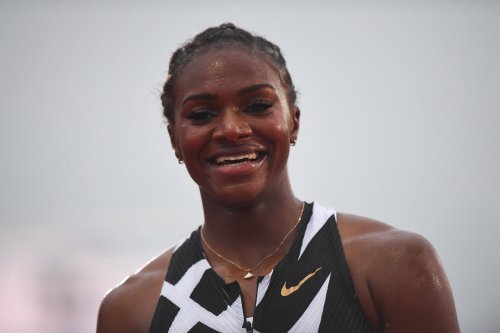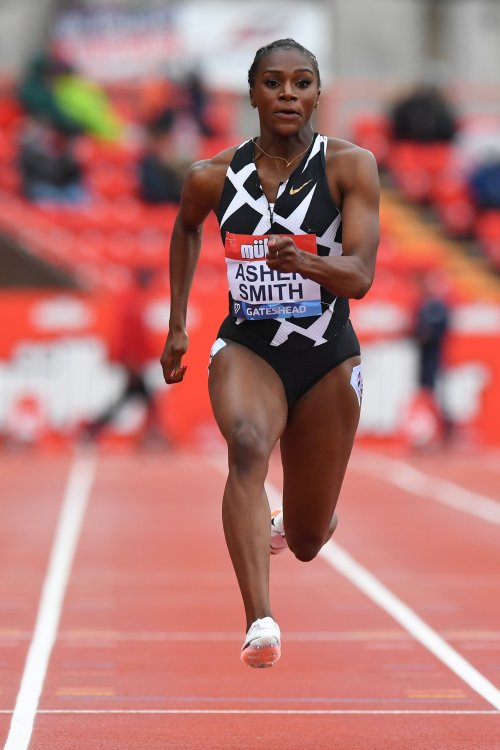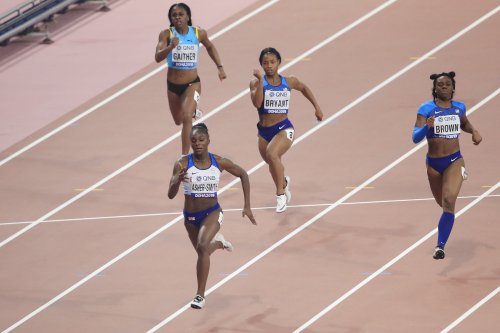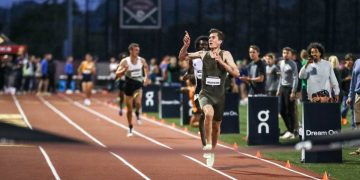In all global championships, there are high moments and low moments. In Great Britain, Dina Asher-Smith has been a huge star. In 2019, Dina took bronze in the 100m and gold in the 200m.
Up until late June, all looked good, when Dina ran a 10.97 for the 100m. She tore a hamstring, and, because it was an Olympic year, she and her coach looked to a second opinion on the injuries.
Many were surprised that Dina Asher-Smith did not make the 100m final, running 11.05 in the semi-final.
In the article below, Stuart Weir allows Dina Asher-Smith to explain what was really going on and why she pulled out, following the advice of her long-term coach, John Blackburn.
 Dina Asher-Smith, photo by British Athletics /Getty Images
Dina Asher-Smith, photo by British Athletics /Getty Images
Dina Asher-Smith, in her own words….
Stuart Weir prefaces Dina’s comments:
The big GB story so far has been Dina Asher-Smith’s failure to make the 100m final, finishing third in 11.05. This was followed by a statement by Dina that the hamstring problem of which we were aware, was, in effect, a lot more serious than had been suggested previously. In a pre-event presser, she had explained that she had pulled out of the Gateshead Diamond League because of a “grumpy hamstring”.
This article is Dina’s statement entirely in her words:
“I am so disappointed not to make the final because it’s Tokyo 2020, everything I’ve trained for the past two years. The last few weeks of my athlete life have been absolutely insane. I wanted to come and be completely upfront with everybody on my form and on life.”
 Dina Asher-Smith, photo by British Athletics / Getty Images
Dina Asher-Smith, photo by British Athletics / Getty Images
“I pulled out of both Stockholm and Gateshead because, in the GB trials final, I actually pulled my hamstring at 60m. I tore it pretty bad. I was initially told in Manchester that it was a rupture and I would require surgery and it would take three to four months to get back. It has been a lot to deal with because quite frankly with that diagnosis, you’re like, ‘I just can’t go to Tokyo.’
“So we had this whole statement ready to go but then, thankfully, I went and got a second opinion – it was a slight misdiagnosis. Even though there was still quite a major tear, it wasn’t a rupture, my hamstring was still attached. So we turned over every single stone to make sure that I could stand on the start-line. Obviously, through that whole process, I’ve gone through the whole thing of running 10.97 at the trials, tearing my hamstring at 60, and shutting down. Then going through the whole thing of ‘Oh, I can’t go’ and then ‘Oh, Ok there’s a chance.
“Thank you so much to all my friends that have known, my family. And obviously, my team that is here and all the doctors, particularly the amazing people in Germany who, since the Tuesday after trials, worked relentlessly to try and get me back on my feet so I could race here today and I’m so grateful to everybody who has put so much work so I could stand on the track and race here tonight. Obviously, I was not my normal self, but it has been quite a journey so I’m really proud.”
“The most frustrating thing for me was the fact that I was in really good shape [when it happened]. I was in the shape of my life and I can say that with my hand on my heart. If you asked me six weeks ago, I was very confident that I was going to win this, being completely frank, because I knew that every part of my race – my start, my transition and my finish – was better than some of the fastest women in the world. But when you get a hurdle like that, suddenly everything rejigs. I had the low of being told ‘It’s impossible for you to be here. And then getting the kind of ‘Oh, there’s a chance.
 Dina Asher-Smith, Doha 2019, Women’s 200m, photo by World Athletics
Dina Asher-Smith, Doha 2019, Women’s 200m, photo by World Athletics
“So, yeah, it’s been a journey and I’m honestly so proud to have come out here and run 11 seconds off a week’s worth of sprint training – because I spent four weeks trying to run again.
“I think I’m likely to pull out of the 200, simply because my coach [John Blackie] just had that conversation with me. John has told me it’s a no, even though that broke my heart because I’m a competitor. You’ve seen me when I was younger go and pop my hamstring on the 200, I would do it because that’s the kind of athlete that I am. But he’s wiser than me and there are far bigger things, I mean it’s the Olympics, but there’ll be another one.”
The 200 is the one, as reigning world champion and I was in such good shape, you just know Olympic champion is not too much of a further step. I don’t want to cry on TV, it’s so embarrassing, but because of the journey and having three weeks off running and a week running slowly and then just the last week, it’s like getting into spikes and go, fingers crossed and hope for the best. I’m really proud to have been able to execute my races here today and I’m really proud of everything I’ve done to this point.
“But when you are talking about the standard I want to be at and that I know I’m capable of. There are plenty more championships for me to come and kill.
We are in the middle of a four to five-year cycle and yes I got a hamstring tear at the most inconvenient time, but it doesn’t really change the fact of the caliber of athlete that I am”.
Author

Since 2015, Stuart Weir has written for RunBlogRun. He attends about 20 events a year including all most global championships and Diamond Leagues. He enjoys finding the quirky and obscure story.
View all posts




















